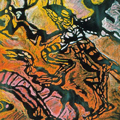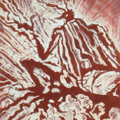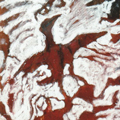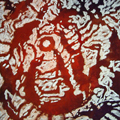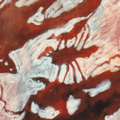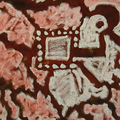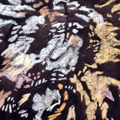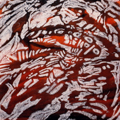The extensive body of work, visual and written, created between the years 1994 and 2000 that comprises The Art of Eddie Burrup is the final phase in the evolution of Elizabeth Duracks oeuvre. In spirit and purpose it aligns with all that came before; it can be traced back some 60 years. It was nascent in the 1930s and probably first emerged in recorded visual form via The Whirlwind drawings and paintings of 194041. Towards the end of her life through her daemon, Eddie Burrup Elizabeth Durack distilled a lifetime of living and learning, of giving and taking, of exploring, reflecting upon and of recreating lost worlds of an ancient culture. Her art is homage to this culture. It also honours and fulfills an exceptional talent.
In the relatively few examples presented here The Art of Eddie Burrup clearly references works from The Rim, the Rim of our brittle and disintegrating world a continuum that emerged in the early 1970s. (References to other phases may be more oblique but in all, the same mind and eye and hand are evident). As in The Rim works, where Dantean images float out of caves and darkness, The Art of Eddie Burrup exists within its own disturbing milieu.
Catalogue notes from Glimpses from the Ngarangani the first solo exhibition of The Art of Eddie Burrup held in Broome, Western Australia, in July 1997 throw some light upon its central theme:
In a Dream world the twilit world of the Ngarangani totemic creatures from an archaic hierology are in turmoil. Embattled, neglected, marooned they inhabit The Art of Eddie Burrup.
The aridified petroglyphs of the Pilbara the fading Wandjina of the Kimberley, remnants of old ceremonies and half-remembered legends
a macrocosm once so undisturbed is plunged into an ever-accelerating state of change and beset with vexed emotions regret and hope, nostalgia and cupidity
The Art of Eddie Burrup incorporates all these diverse elements.
And in the catalogue of the next solo show, The Art of Eddie Burrup, presented by The Rebecca Hossack Gallery, London, in 2000, Leon Deutsch says:
... Eddie Burrups visions are wildly eclectic unpredictable, often inconsistent, always volatile. They range from classical Ngarangani to random incident within historical times, fragments from the lives of the Creation Ancestors or from the lives of old stockmen, increase ceremonies, devils, even Bible stories. The visions of Eddie Burrup are unified by a coda of their own.
In the same catalogue, the art and literary critic, Maureen Smith, says:
the story of Eddie Burrup and The Art of Eddie Burrup is a resource. Much of what it contains is no longer retrievable. With it elliptical time as obtained in the Ngarangani is reasserted and who can say that a new paradigm for reconciliation has not been defined?
Ernie Bridge singer, songwriter, MP and Member for Kimberley for many years had this to say about Elizabeth Durack and her art:
... To view the work of Eddie Burrup is to see the world through the eyes of a woman whose soul is imbued with a deep affection and understanding of the land and its indigenous people.
